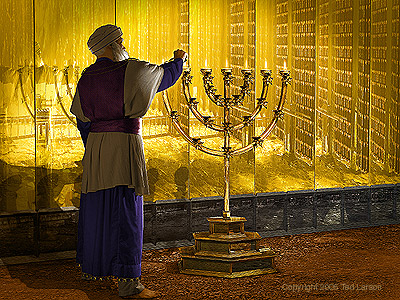Exodus 25:2-7 Speak unto the children of Israel, that they bring me an offering
The Israelites “spoiled” the Egyptians when they left, taking “jewels of silver, and jewels of gold, and raiment” (Ex. 3:22). Now the Israelites had plenty to donate to the building of the tabernacle, whether gold, silver, or fine linen. How did the Israelites respond to Moses’ request? “The people so freely offered for the service of the work that they had to be restrained from bringing. There was more than sufficient for all the work to make it (Ex. 26:5-7).” (BD: “Tabernacle”)
Josephus
The Israelites rejoiced at what they had seen and heard… for they brought silver, and gold, and brass, and of the best sorts of wood, and such as would not at all decay by putrefaction; camels' hair also, and sheep-skins, some of them dyed of a blue color, and some of a scarlet; some brought the flower for the purple color, and others for white, with wool dyed by the flowers aforementioned; and fine linen and precious stones, which those that use costly ornaments set in ouches of gold; they brought also a great quantity of spices; for of these materials did Moses build the tabernacle, which did not at all differ from a movable and ambulatory temple… The women also were ambitious to do their parts, about the garments of the priests, and about other things that would be wanted in this work, both for ornament and for the divine service itself. (Antiquities of the Jews, Book III, 6:1)
Exodus 25:8 let them make me a sanctuary; that I may dwell among them
The Tabernacle that the Lord commands Moses to build is the first recorded temple in scripture. That in and of itself is pretty amazing—that there was no record of a temple for worshipping the Lord prior to the days of Moses! Since the children of Israel were going to be wandering for 40 years and living in tents, even the Lord’s house would be a portable temple—the world’s most elaborate tent—a dwelling for the God of Abraham, Isaac, and Jacob.
“The tabernacle of Moses and the temple of Solomon were but copies of the genuine mountain temple… They became small, man-made mountains designed to replace Sinai as the dwelling place of Yahweh. In the case of the tabernacle, it was a mobile mountain, so to speak, a moving dwelling place; and in the instance of the temple of Jerusalem, it also became a residence for Yahweh. Consequently, Sinai became known as the ‘mountain of God’; the tabernacle was called ‘the tent of God’; and the Jerusalem temple was referred to as ‘the house of God.’” (John M. Lundquist and Stephen D. Ricks, eds., By Study and Also by Faith: 2 vols. [SLC and Provo: Deseret Book Co., FARMS, 1990], 1: 484)
The Tabernacle of Moses

Exodus 25:10-22 The Ark of the Covenant

Exodus 25:16 thou shalt put into the ark the testimony which I shall give thee
The ark of the covenant contained the tablets of the 10 commandments, a pot of manna, and Aaron’s rod that budded (Heb. 9:4; Ex. 7:12). It was placed in the Holy of Holies—the most sacred spot in the Tabernacle.
Exodus 25:21-22 thou shalt put the mercy seat above upon the ark… and There I will meet with thee, and I will commune with thee
Bruce R. McConkie
On top of the ark rested the mercy seat, a cover of pure gold, symbolizing to the mind that because of the atonement yet to be wrought, repentant souls would find mercy before the eternal throne. The mercy seat, serving as it were as the throne of God, was a symbol of his forgiveness and of his goodness and grace in providing mercy through his atonement. Once each year on the Day of Atonement, the high priest entered the Holy of Holies, thus testifying anew to all the people that mercy might be theirs through the great propitiatory sacrifice that was to be. And the two cherubim—overshadowing the mercy seat with their wings—bore record that the ark itself was the very throne of God set up among his people and that Jehovah did in fact dwell in his house and was among them. (The Mortal Messiah: From Bethlehem to Calvary, 4 vols. [Salt Lake City: Deseret Book Co., 1979-1981], 1: 101)
Exodus 25:23-30 The Table of Shewbread


On the Table of Shewbread were 12 loaves of bread and frankincense symbolic of the future Messiah, the Bread of Life (John 6:48).
“The cakes were to be left on the table for a week, and then be replaced with new ones on the Sabbath, so that there were always fresh loaves on the table, and those that had started going stale were removed; the Biblical text states that the Jewish priests were entitled to eat the cakes that had been removed, as long as they did so in a holy place, as it considered the bread to be holy. The narrative of David's sojourn at Nob mentions that Ahimelek (the priest) gave David the holy bread, at his request. (1 Sam. 21:4-6)” (https://en.wikipedia.org/wiki/Showbread#cite_note-autogenerated1-30)
Exodus 25:31-40 The candlestick


The three partitions in the tabernacle of Moses represent the three degrees of glory. The inner tent of the Tabernacle, outside the veil from the Holy of Holies, is called the Holy place. It is where the candlestick, the table of shewbread, and the altar of incense were located. The priest would refill and relight the candlesticks daily. For a history of the candlestick, called the Menorah by the Jews, see http://bibeltemplet.net/Menorah.html .
